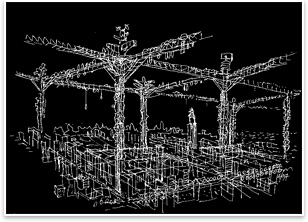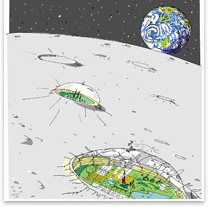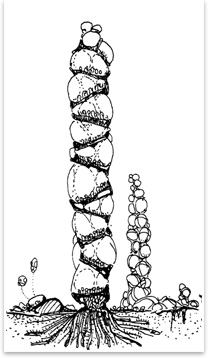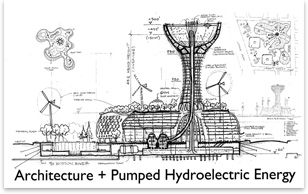
| FANTASY ARCHITECTURE Toward an Ecological Architecture Optimistic visions of a high-density, high-tech, sustainable civilization Ed. Note: Jeff Miles has been using fantasy architecture as a vehicle for exploring ecological solutions for the last 15 years. Below are some sketches of his earlier ideas, culminating in an award-winning international Green Ground Zero Competition, sponsored by New York City’s Municipal Arts Society in 2004.
What would our ethical responsibilities be for construction on new worlds? Does the lunar wilderness deserve protection? Imagine a lunar Environmental Impact Statement! Building underground, in select domed craters, could be a relatively benign way to build on the moon.
4. Green Ground Zero The concept: To harvest renewable energy onsite and store it until needed in a pumped hydroelectric plant that is integrated architecturally within a mixed-use office and retail complex, achieving 100 percent energy self-sufficiency.
Urban application: Pumped hydroelectric as an urban energy storage strategy, combined with a building, is a unique application. The amount of energy in a given volume of water is related to height (hydraulic head), as well as the overall system efficiency, typically 73 percent. A height of 150 m (492 feet) was selected as a compromise among height, volume, and land area. Water would flow through the plant during the 12-hour workday. Renewable power sources would run the pumps daily, refilling the upper reservoir by the next morning. Output: Wind production is based on AEO (annual energy output) tables, DOE wind maps, and manufacturers performance charts. (More sophisticated analysis is necessary to test the concept and establish the optimum system design points.) Balancing energy production and consumption is feasible within the WTC site, given the stated assumptions. The limiting criteria is the amount of renewable energy that can be produced on site, which results in a building of approximately one million gross square feet and a floor-area-ratio (FAR) of 2.7, less than the midtown Manhattan average of 10. Storage: During optimal production, average wind and solar power (5.21MW) exceed the average demand of 1.6MW by more than three times. This excess power could be used to refill the storage reservoir, which would then be utilized as a backup, and not as the primary power source. Assuming a doubling of total system energy efficiency, a higher building density of 5.4 FAR could be achieved, equivalent to London, Paris, and other major urban centers. Other options: For high-density cities like New York to become energy self-sufficient and weaned of the fossil-fuel addiction, clearly other types of renewable sources will have to be developed, such as tidal, geothermal, and biomass. A logical alternative would be to import energy from large municipal offshore wind and PV platforms. Given the high cost of constructing elevated cisterns, perhaps a more distributed hydroelectric storage would be more appropriate, such as one larger reservoir every 10 blocks or so. Other forms of energy storage would also have to be considered (ice caverns, thermal, flywheels, compressed air) and even exotic technologies like superconduction magnetic energy storage (SMES). Conclusion: An energy self-sufficient Ground Zero and, eventually, a zero-footprint civilization, would provide a fitting tribute for the World Trade Center. |
||
Copyright 2007 The American Institute of Architects. All rights reserved. Home Page |
||
out there
down here
here to there
back to earth




